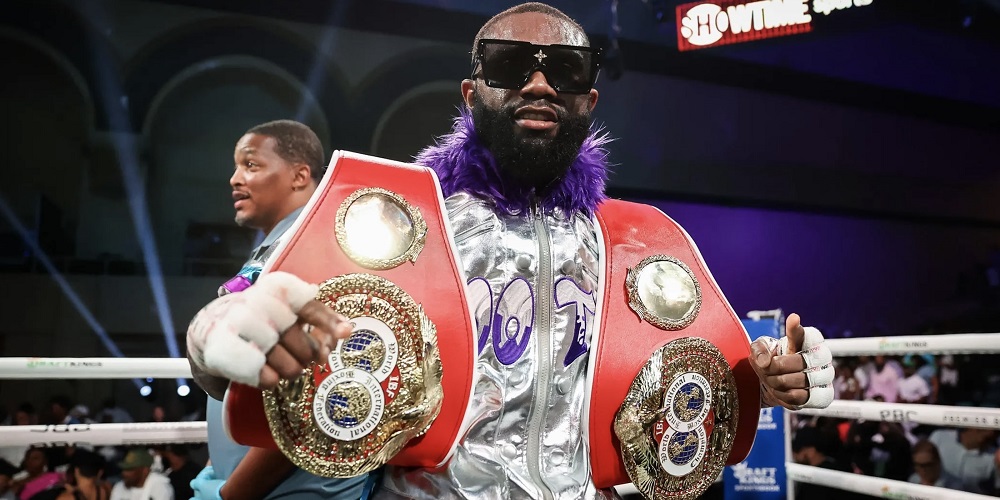From “Jaron Ennis is the new Roy Jones Jr. and will dominate boxing all the way up to light heavyweight” to “Jaron Ennis is a defenseless bluff and will get knocked out by the first worthy opponent.” One thing I’ve learned about the diverse world of boxing enthusiasts is that their judgments swing up and down like rollercoaster cars: overnight, champions transform into journeymen, and underdogs become phenomenal contenders—at least until the next turning point. Nothing new, but I’ll give you a piece of advice anyway: don’t underestimate Jaron Ennis.
The American boxer, who has built an impressive professional record of 33 consecutive victories, 29 by KO, saw his stock dip (at least in the eyes of a significant number of observers) following his last IBF welterweight title defense against Karen Chukhadzhian.
After already defeating the Ukrainian in a dominant fashion nearly two years ago, without conceding even a single round on the judges’ scorecards, Ennis was expected to deliver another commanding performance, perhaps this time sealing it with one of his sensational knockouts. Instead, the champion struggled more than expected, took a significant number of hard shots, and finished the match slightly out of breath.
Many underestimate the importance of a boxer’s psychological state going into a fight; yet boxing history has taught us that this is often a decisive factor. I myself have fallen into this trap more than once, as when, after watching a lackluster Sergiy Dervyanchenko struggle against the naturally smaller Jack Culcay, I was convinced he’d be easy prey for Gennady Golovkin—a prediction that turned out to be far from accurate. Many similar examples could be cited.
Just hours before Ennis vs. Chukhadzhian, I posted this half-joking message on X:
The Jaron Ennis paradox. The only way to do better than in the first fight is to win by KO. But according to Ennis himself, his main mistake in the first fight was trying too hard to get the KO. Let’s see how it turns out.
Although partly ironic, my post pointed out the mental conundrum that Boots was walking into. Forced by the IBF’s highly criticized decision to face the same opponent he had already dominated, Ennis had everything to lose and little to gain, and he likely entered the arena deeply convinced his challenger had no real means to trouble him.
Chukhadzhian surprised him from the opening round, meeting him in the center of the ring and landing a violent hook to the temple that pushed Ennis back a couple of meters. However, the champion didn’t let his opponent’s unexpected aggressive approach unsettle him. On the contrary, for at least seven rounds, he demonstrated high-level boxing.
Certainly, as often happens when a boxer adopts a highly aggressive style against a capable opponent, Boots took some hits. But his speed, his opening jab, his stance-switching, and his vast array of offensive options still dominated the scene, and of the first seven rounds, I personally only gave the fourth to Chukhadzhian.
Then, something shifted. Watching the fight and observing the fighters’ body language, I felt as though I could see inside Ennis’s mind and hear him think: “Why won’t this guy go down? Why does he keep coming forward? Why aren’t my best shots enough to take him out?”
Accustomed to landing devastating blows that overwhelm his opponents, Boots seemed incredulous and annoyed to find himself unable to produce a winning solution this time. As a result, he lost patience, charging forward almost like a ram trying to break down a wall with his head—a strategy that only left him open to counters and sapped his energy in clinches that Chukhadzhian smartly forced.
Critics who vehemently fault Ennis’s defensive gaps should consider one more factor: the challenger’s punches didn’t hurt him. Even after that brutal hook in the first round—especially dangerous since he took it cold—Ennis stayed completely clear-headed, immediately going back on the attack. When a boxer with a strong chin senses he can’t be hurt, it’s not unusual for him to take risks.
We saw Golovkin block plenty of shots with his face against Martin Murray, Kell Brook, and other lesser opponents, only to later use his footwork and defensive jab to neutralize most of the power punches from one of the best counterpunchers in modern boxing history, Canelo, in their first fight. We saw Artur Beterbiev engage in two true slugfests with Callum Johnson and Radivoje Kalajdzic, then show all his technical skills to defeat highly-rated Oleksandr Gvozdyk.
Don’t get me wrong: defense is not and probably never will be Jaron Ennis’s strongest asset, but if you believe he’ll take as many shots in the super welterweight division against a top fighter as he did last Saturday, I think you’re very mistaken.
Boots underperformed compared to his potential. But he did so under the worst possible psychological conditions, against a much better opponent than his reputation suggests, one with courage, durability, footwork, and top-tier ring IQ. If he learns the right lessons from what happened, Jaron Ennis will come back even stronger, and many of those now writing him off will have to reconsider.

